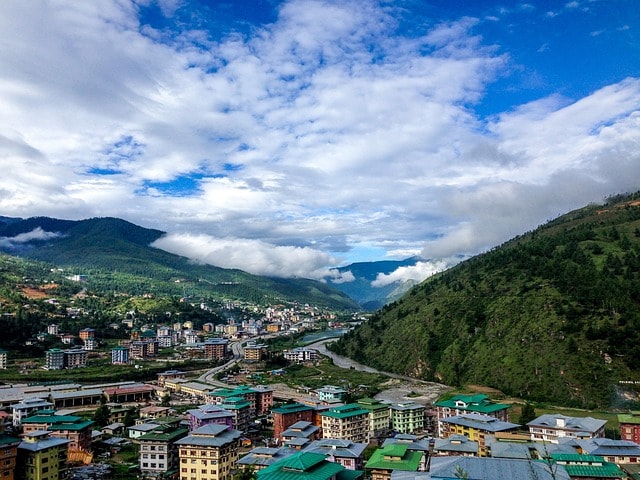Thimphu – The Tranquil Capital in the Clouds

🏛️ A Brief History of Thimphu: The Modern Heart of a Mystical Kingdom
Thimphu became Bhutan’s capital in 1955, replacing the ancient city of Punakha. But despite its administrative importance, Thimphu has never lost its deep-rooted spiritual and cultural identity.
Did you know?
🔸 It’s the only capital city in the world without a single traffic light.
🔸 It was once a collection of hamlets before the monarchy unified it into a capital.
🔸 The Royal Family still lives here in a humble palace surrounded by pine trees — no palatial extravagance.
This is a city where tradition doesn't just survive – it thrives. From centuries-old monasteries to modern coffee shops, it’s a living blend of past and present.
💼 Why Backpackers Love Thimphu
Backpackers aren’t just looking for cheap stays — they’re chasing experience. And Thimphu delivers:
-
Cultural authenticity: No Starbucks, no McDonald’s. Just cozy teahouses, authentic Bhutanese dishes, and monks chatting philosophy at cafes.
-
Budget-friendly: Hostels, homestays, and affordable eateries cater perfectly to budget travelers.
-
Slow travel haven: No pressure to check off “top 10” lists. Thimphu is about soaking in the vibe.
-
Digital detox: Bhutan is one of the few places where you can really disconnect. Wi-Fi exists, sure, but the mountains will call you louder.
📍 Must-Visit Places in Thimphu
⛩️ Tashichho Dzong
The majestic fortress-monastery, glowing golden during sunsets. Also the seat of Bhutan’s government.
🧘 Buddha Dordenma Statue
A 169-ft tall Buddha that watches over the valley. The views from here are surreal.
🎨 Folk Heritage Museum & National Textile Museum
For a glimpse into Bhutanese daily life and their intricate weaving traditions.
🛍️ Weekend Market
From fiery chili powders to handwoven yak wool scarves, the Thimphu Market is an explosion of sights and smells.
☕ Clock Tower Square
A central hub of cafés, live music, and people-watching.
🕵️ Hidden Gems You’ll Only Hear from a Fellow Backpacker
🌲 Wangditse Nature Trail
A short, offbeat trek just outside the city that gives you panoramic views of the valley. Locals often walk here — tourists usually miss it.
📖 Junction Bookstore Café
Hidden inside a bookstore, this café is a serene escape for digital nomads and book-lovers alike.
🍲 Zombala 2 Restaurant
Locals swear by their momos and suja (butter tea). Cheap, delicious, and authentic.
🎭 Royal Academy of Performing Arts
Catch a traditional Bhutanese dance performance if your timing’s right — raw, energetic, and deeply cultural.
🔥 Unique Experiences to Try in Thimphu
-
Try the national dish “Ema Datshi” – a hot, cheesy chili dish that’s not for the faint-hearted.
-
Spin the prayer wheels by the river at dusk while locals chant softly.
-
Join a tshechu festival if your trip aligns – it’s an explosion of color, masks, dance, and tradition.
-
Take a Drayang Detour – Bhutanese karaoke bars that blend music, dance, and storytelling.
-
Ride a local bus through the hills – it’s bumpy but soulfully scenic.
🚍 Travel Tips and Local Guides
🧭 Getting Around
-
Local buses are available but infrequent. Walk or take shared taxis.
-
No Uber here. Negotiate fares with local drivers.
-
Roads are winding — bring motion sickness meds if you're sensitive.
💰 Budget Tips
-
Hostels are around ₹800–1200 per night.
-
Eat at local joints – Bhutanese restaurants serve massive portions at low prices.
-
Visit museums on weekdays — sometimes they’re free or discounted.
🛏️ Hostel Scene
-
Hostels and guesthouses are cozy, clean, and quiet. Try:
-
Thimphu Eco Lodge
-
Urban Retreat Hostel
-
Yee Lodge & Backpackers Stay
-
📱 Handy Apps
-
Maps.me – works better than Google Maps in Bhutan.
-
Druk Ride – for booking long-distance bus rides.
-
Bhutan Telecom – get a local SIM for better coverage.
☀️ Best Time to Visit Thimphu
| Season | What to Expect |
|---|---|
| Spring (Mar–May) | Blooming flowers, mild weather, and tshechu festivals. Perfect for trekking. |
| Summer (Jun–Aug) | Green landscapes but occasional rain. Great for budget travelers. |
| Autumn (Sep–Nov) | Crisp air, clear skies, and stunning views. Peak season for festivals. |
| Winter (Dec–Feb) | Fewer crowds, chilly nights, but sunny days. Snow in the mountains adds magic. |
🌄 Final Thoughts: Why Thimphu Stays With You
Thimphu isn’t the kind of place that overwhelms you — it unwraps itself slowly. It lets you settle in, breathe, and absorb. Whether you're sipping butter tea beside a local monk, hiking through misty pine forests, or just listening to the river rush through the valley, you'll realize this city offers something rare — peace.
For backpackers and hostel hoppers chasing meaning over luxury, Thimphu might just be the most unforgettable stop on your journey.
